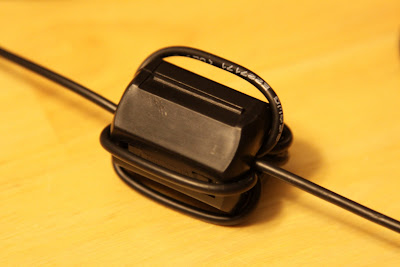I am interested in experimenting with antenna designs, and those that have properties which make them useful for temporary field usage are interesting.
This post is about the construction and measurements of a Resonant Feedline Dipole cut for the 10M band.
The central feed point of the dipole is the open end of the coax . The extended center conductor acts as one half of the dipole. The coax's shield from the "open end" back to the common mode choke acts as the other half of the dipole. Power is delivered to the feed point within the coax its self in the usual way coax transfers power. The choke's distance and extended conductor's length are selected in the usual way.
 |
| 10M Resonant Feedline Dipole |
 |
| Center with temporary strengthening strain relief. |
 |
| 5 turn Choke |
 |
| VNA 2180 |
 |
| Full Sweep 1MHz to 30MHz showing resonance in 10M band |
SWR is the red line in the above figure and the length 7ft 8.25in resulted in resonance being placed in the middle of the 10M band.
The smith chart below shows the input impedance with the antenna connected directly to the analyzer. The second chart shows the change in input impedance with an extended (25ft) feedline. The observation that the impendence versus frequency is somewhat similar asside from a rotation around the chart illustrates the the choke is nearly sufficient to "cut off" the sheld dipole arm.
 |
| 10M RFD with short (6ft) feedline |
 |
| 10M RFD with long (25ft) feedline |
I connected up the iCOM IC7000 and verified that it too saw the same SWR as the VNA.
I can foresee that this form of antenna could be quite handy. It is very simple, light weight and easy to put up either as a sloper, flat top, or even a vertical. Other bands will need seperate versions, obvious changes are needed to strengthen the center connection and higher choke inductance is needed, espically at lower bands.
73
VE3IAC
7 comments:
Nice idea. I had started construction of something similar for 20m. Never got around to finishing it - not sure why, it's so simple!
Think I was using RG58.
Kent VE4KEH
Adrien, I also think this is an interesting concept. If you haven't seen it, check out N5ESE's experiments with the RFD reported here: http://www.n5ese.com/rfd.htm - his results were very disappointing.
I like your experimentation with the VNA ("hard data" :) - please do report results when you try it out.
73, Les, W9XC
I have applied the same RFD concept to a half-square for 20m and it seems to work quite well. The half square is typically fed at the top of one 1/4 wave section for a 50 ohm match which is convenient electrically but not convenient physically as you must keep the feedline perpendicular to the antenna for at least a 1/4 wave in order to avoid interactions between the feedline and antenna (i.e moving the feedline around impacts the SWR). So instead I made the vertical 1/4 wave section where the feedpoint is located out of RG-174 and the rest of the antenna (3/4 wave) out of lightweight wire connected to the center conductor of the RG-174. With a choke balun located approximately 1/4 down the coax you achieve an electrical top feed with the coax attached at the bottom so you get the best of both worlds.
Michael VE3WMB / VA2NB
I use one of these on 10m as a vertical. I cable tied the dipole to a 9mtr Fibreglass Roach Pole and the performance of it with my FT817 is just amazing. The choke is just about 8 turns of RG58u with no toroids being used.
I'd be interested in how you get on with this as I plan to build for other bands.
Peter, Mi5JYK
Hi Everyone,
I had some experiments in making antenna by using AIM4170C ARRAY SOLUTION and by next week I am planning to buy VNA 2180.
Could you please explain to me in regard with the advantages of VNA2180 ?
I am still confused with the graphical result of my experimental antenna by using AIM4170C.
For example when I made an experimental Omni Antenna, which I put the omni antenna on the TRIPOD, then I moved the omni antenna to left side or right side etc, so I found that the graphical antenna result always changed.
Is the problem with the ground effect or something RF ?
could you please explain to me in detail in regard with the changing of the graphical result.
Thanks in advance
Regards,
Kurnia Putra - YC0KPN
I recall first hearing about an "end-fed" dipole such as this from the book "Simple, Low-Cost, Wire Antennas for Radio Amateurs" by William Orr (W6SAI) & Stuart Cowan (W2LX). That was back in 1982 when I was a teenager and I recently recalled the vertical dipole that could be hung from a tree limb that they dubbed a "cobra vertical".
As I've built HUNDREDS of antennas over the years, my recollection of ever getting that convenient to deploy design up in the air and tested is kind of sketchy at best. So I wonder if there are any updates on success or failure? My hope is to revisit it so I'll try to remember to share any results that I obtain. My hope is that it proves out well but I'm trying not to get too excited as one would think that there would be more people out there championing this general design.
73 and thanks for sharing. Paul NT7U
Have a look at:www.dxfreun.de RFL-Antenna 2017
Post a Comment